class: hide-logo, center, middle # More than the sum of her parts: ## Presenting high femme nonbinary identity across multiple phonetic features **NZLSC 2022, Dec 8-9, Ōtepoti, Aotearoa** Jacq Jones, University of Canterbury .banner[ <img src="images/NZILBB.svg" width="70%" /> ] --- # Intro I: Let's talk about sex Sex/gender is often assumed to be * Binary * Male/Female, Man/Woman. XX/XY, etc * Exclusive * If it's non-male, it is _de facto_ female * Static Even literature examining transgender participants often assumes two binary categories, with trans folks being at some point on a "transition" narrative between assigned sex at birth (ASAB) and the "other" gender. However... -- **Nonbinary people exist**, directly challenging these stereotypes. --- class: title-slide, center, middle # Disclaimer ### This is complicated stuff! --- # Intro II: Let's talk about speech Sex/gender speech stereotypes exist as well * In the literature, particularily variationist/corpus studies * In the minds of speakers and listeners of every gender These stereotypes assume sex/gender is * Still Binary * Still Static * "Macrosocial" or Demographic * Traditional predictor of LVC * e.g. *Women lead sound change* (Labov, 1994) --- # Intro III: Why Nonbinary? Examining Nonbinary speakers offers unique insight into the ways sex/gender shapes language: * Potential Mismatch between speaker identity and listener assumptions * Speakers lack a template of "How to sound nonbinary" **∴** Speakers may recombine existing features to challenge assumptions or create perceptual "space" for themselves. e.g. via bricolage (Eckert 2008, Zimman 2017) Direct comparisons with nonbinary and binary peers allows an examination of what's salient about gender in speech from the "outside" --- # Intro IV: The <span style='color:#FF0000;'>R</span><span style='color:#FFB000;'>A</span><span style='color:#02C43A;'>I</span><span style='color:#004EFF;'>N</span><span style='color:#6200FF;'>B</span><span style='color:#FF00EB;'>O</span> Corpus <span style='color:#FF0000;'>R</span>ecorded <span style='color:#FFB000;'>A</span>udiovisual <span style='color:#02C43A;'>I</span>nterviews with <span style='color:#004EFF;'>N</span>onbinary and <span style='color:#6200FF;'>B</span>inary <span style='color:#FF00EB;'>O</span>rators. * LaBB-CAT Corpus (Fromont & Hay, 2012) * 16 Participants * 6 nonbinary, 5 binary male, 5 binary female * 18-52 years old; age-matched across gender * ~35 Hours recorded (~20 transcribed) across 78 Recordings * 3-6 "In the Wild" recordings * Sociolinguistic interviews (30-90mins) * Traditional Qs * Gender Qs * Selfies Today, I'm focussing on one nonbinary speaker, Istus. --- # Intro V: Meet Istus (20) ### <center>In her own words</center> .pull-left[.pull-left[##### Deep down I'm, you know, high femme except I'm also a weird genderless potato person. ##### \[Masculinity\] is basically the least relatable thing on the planet, after hyenas.] .pull-right[##### Generally I try and present like the least gendered way possible, um, and then some days I’ll have like the high femme day where it’s dresses and makeup and heels and pretty sparkles and it’s **winter** [so] I don’t want to do any of that, it’s **cold**. ]] .pull-right[.pull-left[##### Most cisgender people tend to take everything at face value and stuff... literally all I need to do is put on a dress and a bra and I get read as female, but if I do anything short of that it’s like, _"Oh, you’re a man."_ ] .pull-right[##### People who aren't cis are allowed to be vague with things as well, you know. Women can wear pants. [but] _Oh? You're trans? A trans women? Tell me more about how you want to be a 1950s housewife._ ]] --- class: middle # Pitch # <span style='color:#A0C267;'>Intervocalic /t/</span> # <span style='color:#A0C267;'>VtV + Make-up</span> --- layout: true # Pitch --- .left-column[ ### Context Mean: 130Hz ] .right-column[ <img src="images/Pitchbin_justIst.png" width="100%" style="display: block; margin: auto;" /> ] --- .left-column[ ### Context Pitch Bin comparison to other nonbinary participants ] .right-column[ <img src="images/NB_Pitchbins.png" width="100%" style="display: block; margin: auto;" /> ] --- .left-column[ ### Context Very little variation cross-context, so even subtle variation away from this baseline represents a meaningful shift ] .right-column[ <img src="images/NB_Pitchbins_Sq.png" width="100%" style="display: block; margin: auto;" /> ] --- .left-column[ ### Example 1 Natural v. Normal <audio controls style="width: 200px;"><source src="sounds/IstNatNor.wav" type="audio/wav"></audio> ] .right-column[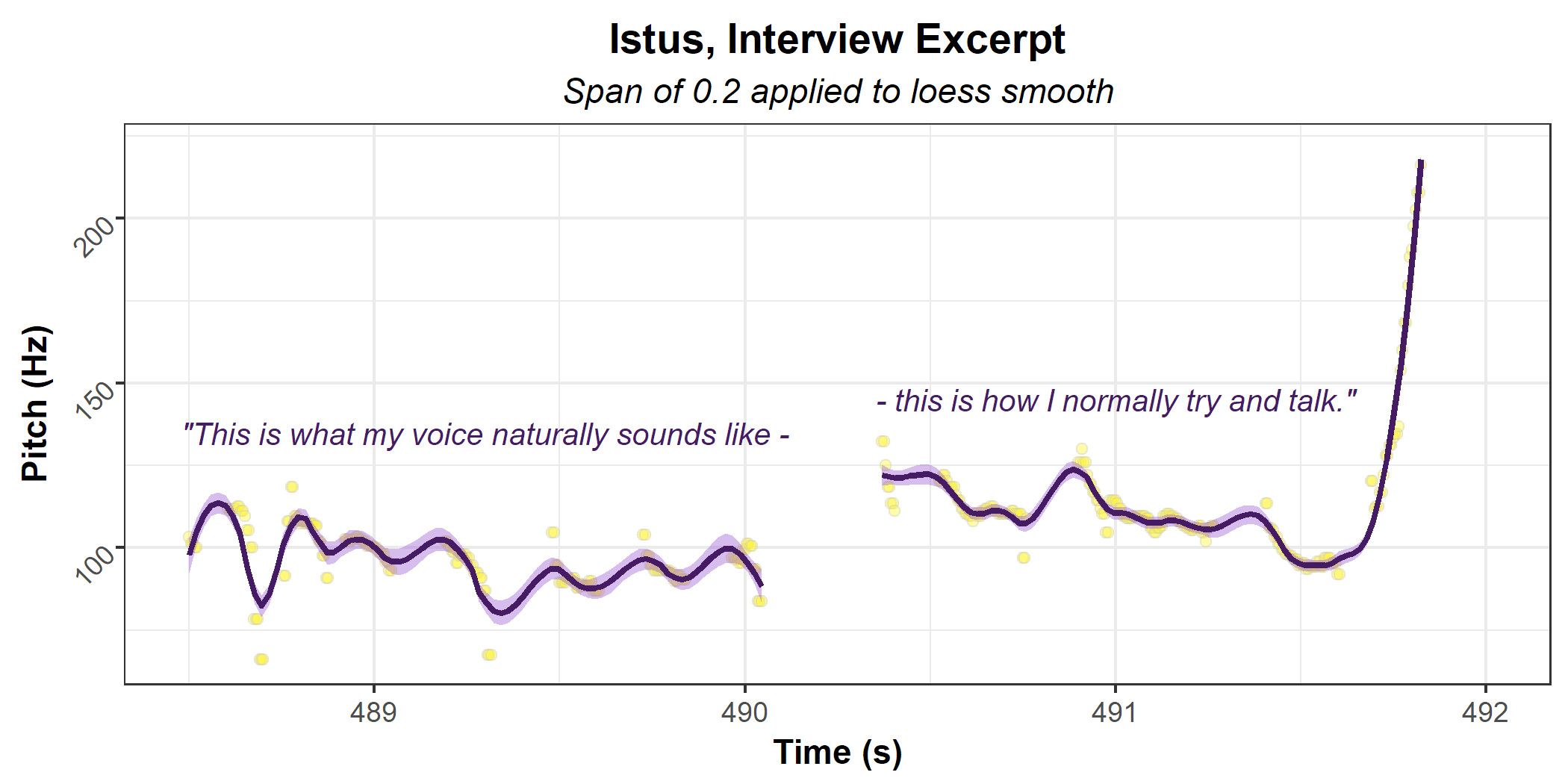] --- .left-column[ ### Example 2 Using pitch to challenge. <audio controls style="width: 200px;"><source src="sounds/Isthello.wav" type="audio/wav"></audio> ] .right-column[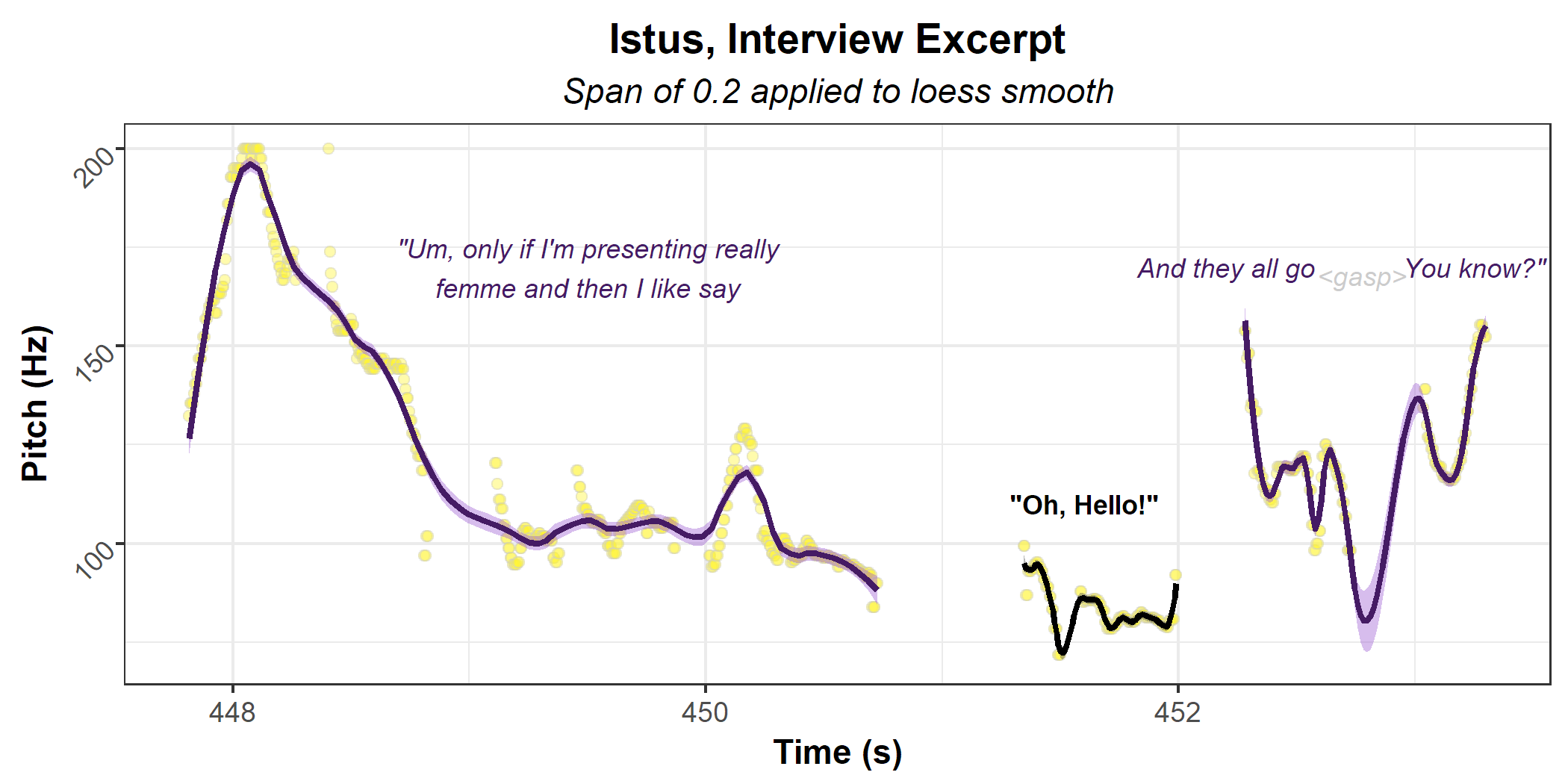] --- .left-column[ ### Example 3 <audio controls style="width: 200px;"><source src="sounds/IstCali.wav" type="audio/wav"></audio> Using pitch changes to explore her relationship to different forms of femininity <audio controls style="width: 200px;"><source src="sounds/Istdoathing.wav" type="audio/wav"></audio> ] .right-column[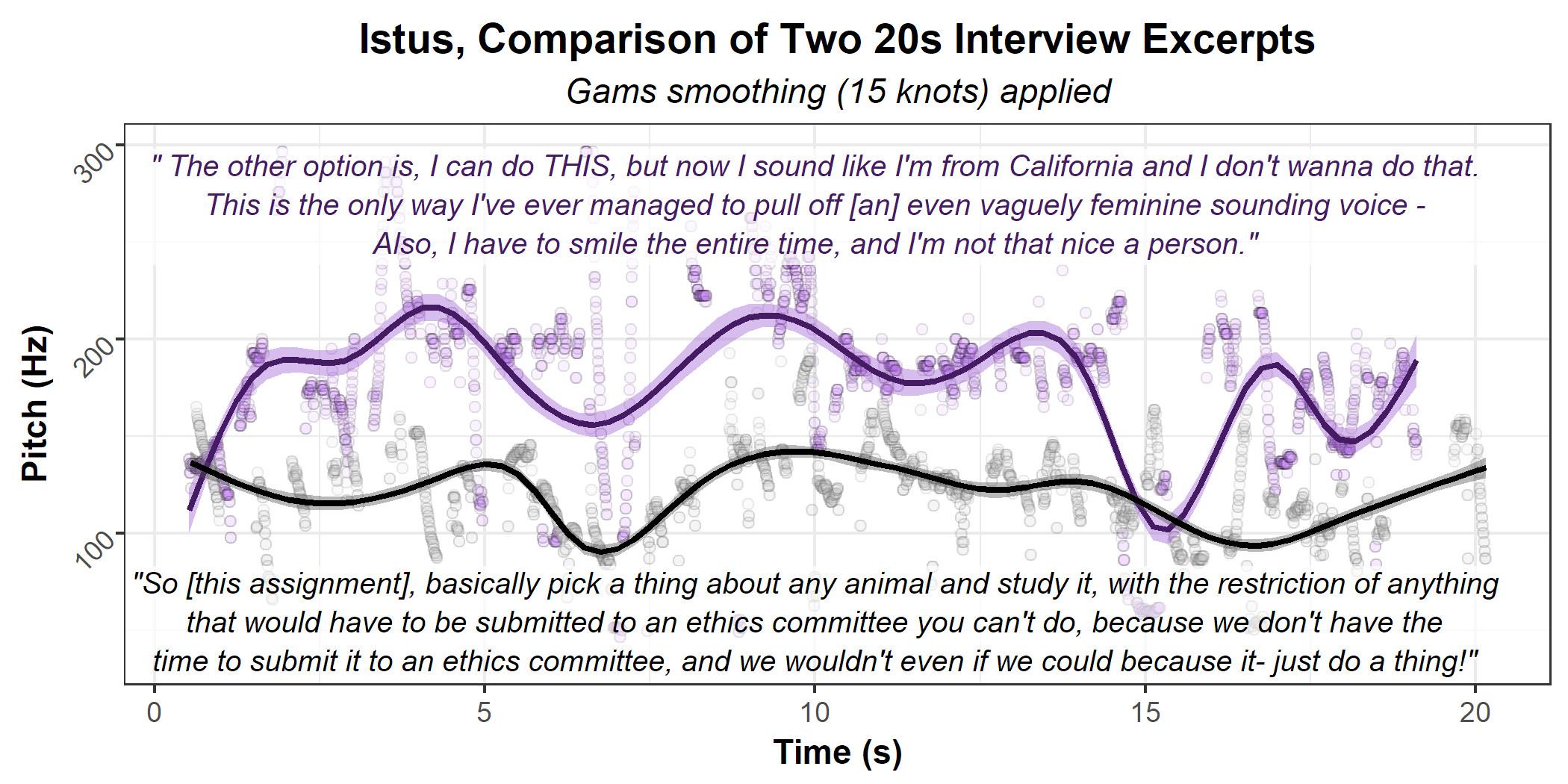] --- class: middle # <span style='color:#A0C267;'>Pitch</span> # Intervocalic /t/ # <span style='color:#A0C267;'>VtV + Make-up</span> --- layout: false # Intervocalic /t/ In New Zealand English... * Traditionally canonical [t] * Currently mostly [ɾ] * But still correlated to working class, younger, and male speakers * [t] and [tʰ] associated with middle- and upper-class women * In AusE, also associated with older women and gay men (Taylor 1996; Tollfree, 2001) * And and [ʰt] too! (Fiasson, 2016) --- # Intervocalic /t/ .left-column[ ### Context] .right-column[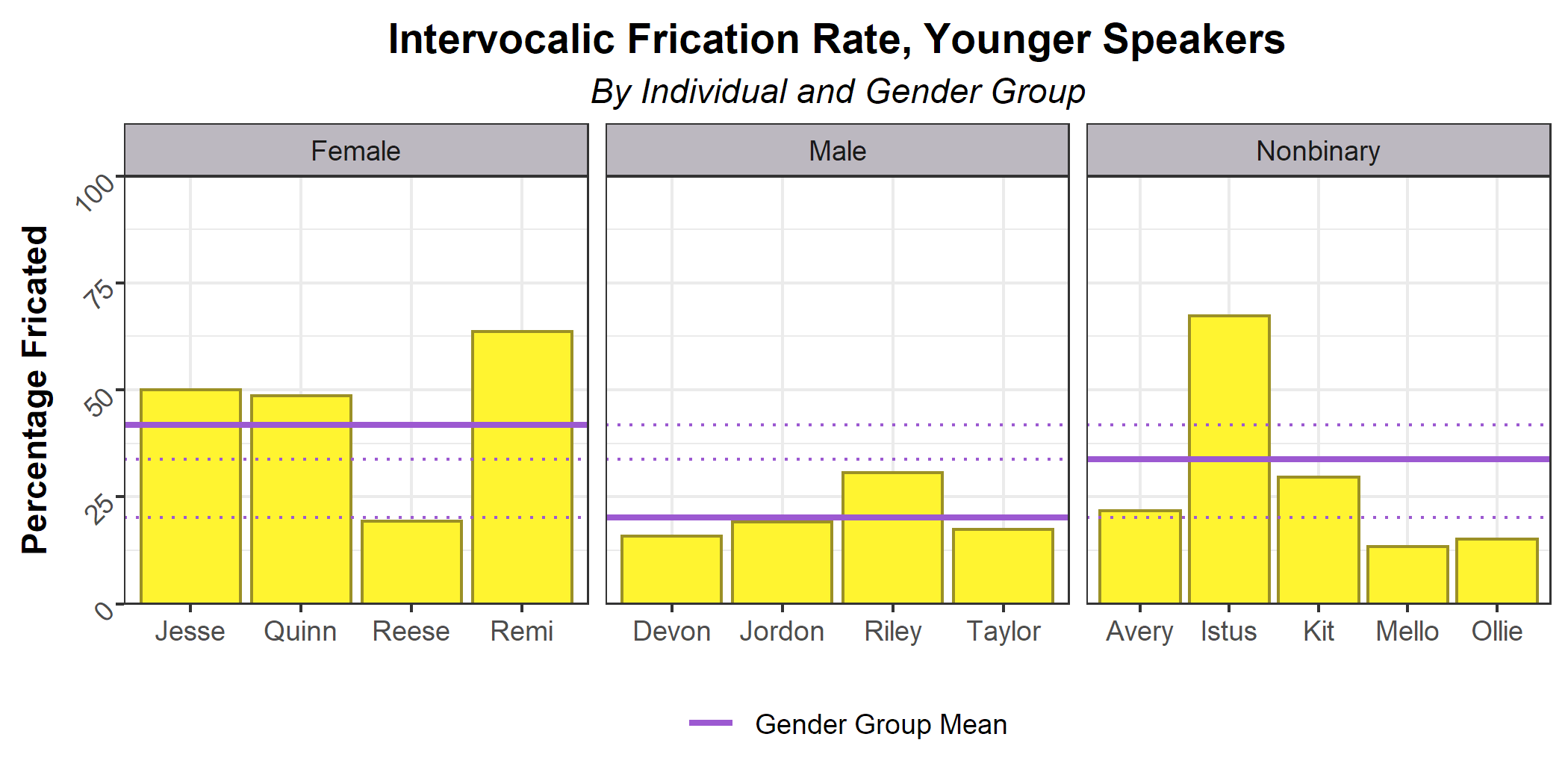] --- # Intervocalic /t/ .left-column[ ### Context VERY high rates of frication relative to other speakers ] .right-column[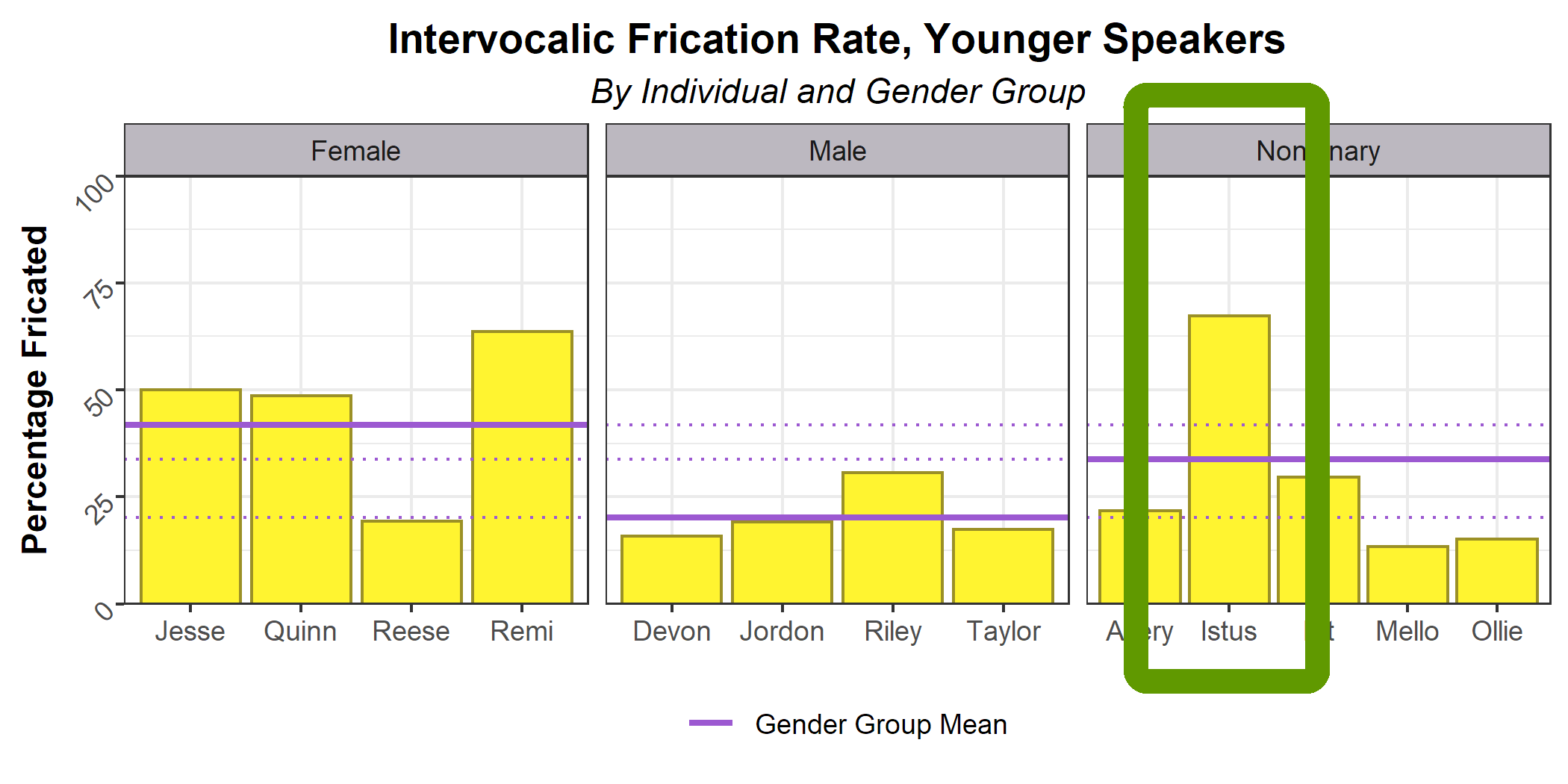] --- # Intervocalic /t/ .left-column[ ### Example 1 Production shifts align with shifts in temporal perspective. <audio controls style="width: 200px;"><source src="sounds/cooties.wav" type="audio/wav"></audio> ] .right-column[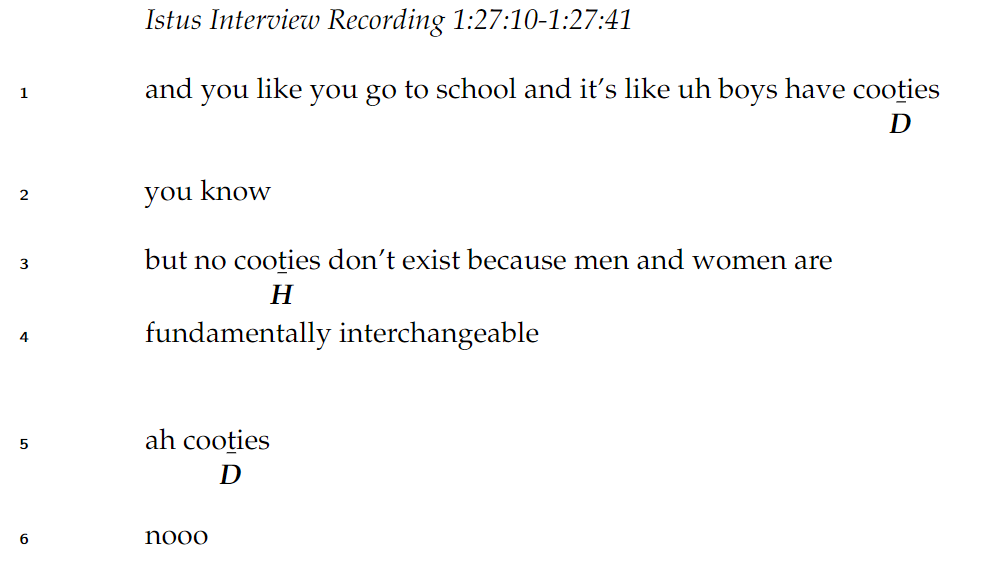] --- # Intervocalic /t/ .left-column[ ### Example 2 Production with position towards/alignment with femininity as a great concept or in/outgroup. <audio controls style="width: 200px;"><source src="sounds/istflapFemm.wav" type="audio/wav"></audio> ] .right-column[ <img src="images/istFlapFemm.png" width="90%" /> ] --- class: middle # <span style='color:#A0C267;'>Pitch</span> # <span style='color:#A0C267;'>Intervocalic /t/</span> # VtV + Make-up --- # Intervocalic /t/ + Visual Domain .left-column[ ### Example 3 Production shifts align with use of makeup * Maintenance? * Competing forms of femininity? <small>(Gurrieri & Drenten, 2021)</small> ] .right-column[ <img src="images/Fric_Ist.png" width="100%" /> .pull-left[<audio controls style="width: 150px;"><source src="sounds/cate_int_h.wav" type="audio/wav"></audio><audio controls style="width: 150px;"><source src="sounds/cate_int_h_short.wav" type="audio/wav"></audio>] .pull-right[<audio controls style="width: 150px;"><source src="sounds/cate_itw_f.wav" type="audio/wav"></audio><audio controls style="width: 150px;"><source src="sounds/cate_itw_f_short.wav" type="audio/wav"></audio>] ] --- # Conclusion Across phonetic contexts, Istus asserts a nonbinary identity that is **also** high femme. These aren't in conflict with each other, though Istus identifies a number of conflicts between her sense of self and hegemonic gender stereotypes. Istus establishes her nonbinary femininity through multiple phonetic cues * Deep awareness (and control) of her pitch to adopt, reject, and challenge stereotypes. * Variable use of intervocalic /t/ frication * In storytelling * In reference to the visual domain. Istus is only 1 of 6 Nonbinary speakers in <span style='color:#FF0000;'>R</span><span style='color:#FFB000;'>A</span><span style='color:#02C43A;'>I</span><span style='color:#004EFF;'>N</span><span style='color:#6200FF;'>B</span><span style='color:#FF00EB;'>O</span>! --- class: middle #### <center>**References**</center> <small><small><small><small>Eckert, Penelope (2003). “The meaning of style”. _Proceedings of the Eleventh Annual Symposium about Language and Society_<br> Fiasson, Romain. (2016). “Frication, pre-aspiration and tapping of medial/t/in New Zealand English”. _Te Reo_ 59, pp. 47–69.<br> Fromont, Robert and Jennifer Hay (2012). “LaBB-CAT: An annotation store”. _Proceedings of the ALTA Workshop 2012_, pp. 113–117.<br> Gurrieri, Lauren and Jenna Drenten (2021). “The feminist politics of choice: lipstick as a marketplace icon”. _Consumption Markets & Culture_ 24.3, pp. 225–240.<br> Labov, William (1994). _Principles of Linguistic Change: Volume 1: Internal Factors._<br> Taylor, Ben (1996). Gay men, femininity and/t/in New Zealand English. Tech. rep. _Wellington Working Papers in Linguistics._<br> Tollfree, Laura (2001). “Variation and change in Australian English consonants”. _English in Australia_. Blair & Collins (eds.), pp. 45–67.<br> Zimman, Lal (2017). “Gender as stylistic bricolage: Transmasculine voices and the relationship between fundamental frequency and /s/”. _Language in Society_ 46.3, pp. 339–370.</small></small></small></small> # <center>Thanks! Slides created via the R packages [**xaringan**](https://github.com/yihui/xaringan) and [gadenbuie/xaringanthemer](https://github.com/gadenbuie/xaringanthemer), with copious ~~theft~~ borrowing from Joshua Wilson Black's code. The chakra comes from [remark.js](https://remarkjs.com), [**knitr**](http://yihui.name/knitr), and [R Markdown](https://rmarkdown.rstudio.com).</center> --- class: title-slide, center, middle # Extra Slides --- class: inverse, center background-image: url(images/All_Pitchbins.png) background-size: contain --- # VtV Praat .pull-left[ <img src="images/femininity_canonical.png" width="100%" /> ###### Full Word <center><audio controls><source src="sounds/femininity_canonical.wav" type="audio/wav"></audio></center> ###### /t/ <center><audio controls><source src="sounds/femininity_canonical_part.wav" type="audio/wav"></audio></center> ] .pull-right[ <img src="images/femininity_preasp.png" width="100%" /> ###### Full Word <center><audio controls><source src="sounds/femininity_preasp_full.wav" type="audio/wav"></audio></center> ###### /t/ <center><audio controls><source src="sounds/femininity_preasp.wav" type="audio/wav"></audio></center> ]